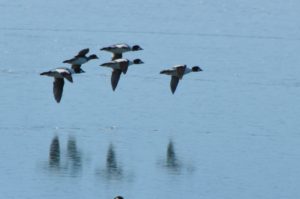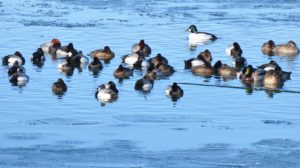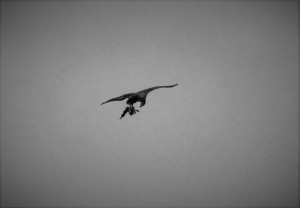Photography courtesy of Lowell Washburn, all rights reserved.
Notes on Goldeneyes – Shotguns – and Eagles
For Iowa duck hunters, the appearance of migrating goldeneyes is a bittersweet moment. Although a prime goldeneye drake is regarded as a waterfowling trophy, the species’ arrival signals the beginning of the end. Make no mistake. Open water has been officially put on notice. Freeze-up is at hand. Like it or not, your duck season is about to end.
A hard flying, deep diving inhabitant of big waters, the goldeneye is one of the few sea ducks to regularly visit Iowa. As tough as a water bird can get, goldeneyes refuse to budge until even the deepest northern lakes begin to freeze. Southbound flocks are the grand finale of the annual migration.
Commonly referred to as “whistler”, the goldeneye’s rapid wingbeat emits a distinctive sharp whistle that, under clear and calm conditions, can be heard for a half mile or more. This is one duck species that is often heard before it is seen. Wary and clickish, goldeneyes generally keep to themselves. When birds are on the move, adding three or four whistler decoys to the outside of the spread will greatly enhance your chances of luring the species to decoys.
Although I’ve had opportunity to pursue diving ducks in three of America’s great flyways, I have not managed to bag all that many goldeneyes. But the encounters that I have had with the species have been most enjoyable. My formal inanition to the bird occurred during the 1960s’ when my father and I were hunting the rocky shoreline of a large lake. A heavy fog had settled in at sunrise — a fog so thick that visibility was limited to almost nothing. Dad was hiding in our shore blind but I, for some odd reason, had decided to sit atop a boulder situated a few feet out into the water. There had been no sign of ducks until we suddenly heard the sound of whistling wings; a distinct signature that told us goldeneyes were in the air. For the next several seconds the sound steadily increased in volume but, peer as we might, we could not detect the ducks. Strangely amplified by the thick fog, the whistling soon took on a surround-sound effect that seemed to come from all directions. And then they appeared; two beautiful goldeneye ducks blazing out of the fog on a coarse that would lead them directly over the top of me and my granite perch.
I was cradling one of my favorite shotguns that day; a Springfield double barreled 12 gauge. The vintage side-by-side was fitted with a custom beaver tail for end, double triggers, and a brilliant case-hardened receiver reflecting a kaleidoscope array of colors reminiscent of what happens when oil hits water. I still kick myself for ever trading that shotgun off.
Anyway, as those two ducks came hurtling out of the fog, there was no time for conscious thought. No time to analyze or calculate. In a response of pure reflex, I snapped the 12 bore to my shoulder. By now, the ducks were already passing directly overhead. Leaning back, I quickly snapped the front trigger and then the back. To my utter amazement, both birds folded at the sound of the shots; splashing down in unison just a few yards away. Couldn’t pull that one off again if I had a million years to try.
Another memorable goldeneye close encounter occurred during a bone numbing, blue finger winter’s morning when gunning partner, Bob Humberg, and I hunkered beside the last open air hole on Clear Lake. With the lake locked in ice and covered with six inches of new snow, our season was all but over. But there was some good news. A big band of low flying, mixed divers had swarmed the decoys and five birds had been dropped from the flock. Sandy, my female Chesapeake retriever, eagerly charged into the icy chop, making straight for a wing-tipped goldeneye that had splashed into the center of the spread. But as the retriever drew near, the duck suddenly dove and disappeared beneath the ice. Undaunted, the dog executed her own dive, quickly disappearing in the same direction.
One by one, the moments slowly and painfully ticked by — each second becoming its own eternity as the dog failed to appear. Rushing to the water’s edge, we silently wondered if the dog had lost her way and become disoriented beneath the ice. If so, there could be little hope.
The tension was finally broken as the retriever’s head bobbed to the surface like a giant cork. Even more incredible was the sight of the winged-tipped goldeneye held gently in her mouth. We hailed Sandy’s return with a stress relieving cheer.
Even though the underwater swimming ability of the goldeneye is akin to that of a loon, the Chesapeake had somehow managed to follow, seize and return with her prize. Although I’ll never know what really happened under the ice that blustery morning, one thing is certain. There was never a better day to be accompanied by a witness.
Not all goldeneye hunters carry shotguns. Shortly after freeze-up one December, I was hunting ducks over another Clear Lake airhole. Ignoring my decoys, a small flock of goldeneyes passed me by and landed on the ice a safe distance away. Before long, a bald eagle came lumbering across the lake headed in my direction. But although the huge raptor’s wingbeats may have appeared sluggish, the eagle was moving with deceptive speed. Passing wide of the ducks, the eagle seemed oblivious of their presence. But the ruse quickly became apparent when the bird made an abrupt turn and fired up the after burners. Pouring on the coals, the eagle was on the ducks in an instant. Dropping its huge grapple-hooked feet, the raptor deftly snatched one of the goldeneyes from atop the ice. Never missing a wingbeat, the eagle carried the duck a bit farther across the lake where it landed and quickly devoured the hot meal.
Most people fail to give bald eagles the predacious credit they deserve – especially when it comes to their speed. In 2013, I was babysitting a spread of decoys when an immature bald eagle arrived on the scene. Attaining radar lock on a group of fast-moving scaup [bluebills], the eagle swiftly overtook the ducks. Selecting a plump drake, the raptor cut through the flock like a hot knife through butter. The unfortunate duck was still struggling in the eagle’s talons as they passed. Although a heavy overcast provided extremely poor lighting, I did manage a single grainy photo to document the occasion.






 Tom Cope
Tom Cope Sue Wilkinson
Sue Wilkinson Susan Judkins Josten
Susan Judkins Josten Rudi Roeslein
Rudi Roeslein Elyssa McFarland
Elyssa McFarland Mark Langgin
Mark Langgin Adam Janke
Adam Janke Joe Henry
Joe Henry Kristin Ashenbrenner
Kristin Ashenbrenner Joe Wilkinson
Joe Wilkinson Dr. Tammy Mildenstein
Dr. Tammy Mildenstein Sean McMahon
Sean McMahon